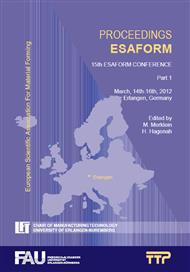p.3
p.17
p.23
p.29
p.35
p.41
p.47
p.53
On the Improvement of Formability and the Prediction of Forming Limit Diagrams at Fracture by Means of Constitutive Modelling
Abstract:
Sheet metal forming processes are well-established in production technology for the manufacturing of large quantities. To increase the formability, the processing limit of a single forming process can be enhanced by a combination of quasi-static and high-speed forming process. The forming limits for both operations for the aluminum alloy EN AW 6082 T6 obtained via simulations and experiment are investigated in a research cooperation between the Institute of Materials Science (IW) and the Institute of Applied Mechanics (IFAM). Significant changes in forming limits with higher strain rates are indicated by the experimental results. Here, the forming limit curves move to the lower right hand side. The processes are simulated and the FLD at fracture are predicted by means of finite element analysis. The constitutive model is based on the multiplicative split of the deformation gradient. It is coupled with ductile damage and combines nonlinear kinematic and isotropic hardening. The kinematic hardening component represents a continuum extension of the classical rheological model of Armstrong–Frederick kinematic hardening. The coupling of damage and viscoplasticity is carried out following the well-known concept of effective stress and the principle of strain equivalence. Using these powerful tools the simulation of dynamic effects and the prediction of forming limit diagrams at fracture shows good correlation with the experiments.
Info:
Periodical:
Pages:
29-34
Citation:
Online since:
February 2012
Price:
Сopyright:
© 2012 Trans Tech Publications Ltd. All Rights Reserved
Share:
Citation:


